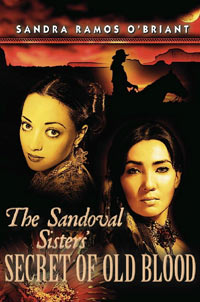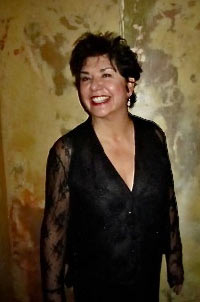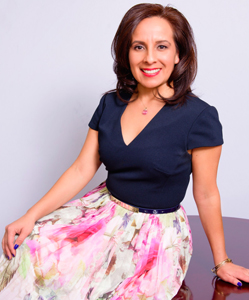This week, TheLatinoAuthor.com is featuring author Sandra Ramos O’Briant. She grew up in Santa Fe, New Mexico as well as spending summers in Texas; however, she currently resides in Los Angeles, California. Read our interview with Sandra and see what compelled her to pursue her career as an author.


Can you begin by telling us a little bit about yourself; where you grew up, where you currently reside, family upbringing, or anything that you would like our readers to know about you?
My hometown is Santa Fe, New Mexico, but I also spent most summers in Texas visiting my father. It was quite a contrast: in Texas children were seen and not heard, and I was expected to act like a young lady. In New Mexico, I ran wild and free with my mother’s approval. The girls in the neighborhood stayed indoors and learned how to cook. Not me. I was the only girl on the neighborhood baseball team. I rode my bicycle all over Santa Fe, and in the winter took advantage of a discarded car hood by laying cardboard over it and then packing snow on it. This created a ramp at the end of a slope leading from a railroad track platform. Our sleds picked up speed and then flew off the hood into a snow bank. I initiated excursions into the storm drains under Santa Fe in search of treasure or decaying bodies. As we grew older, I also played spin-the-bottle with my baseball team. I’ve lived in L.A. for over 30 years and love it.
You’ve written several short stories and now you’ve written a great novel. Why the switch and which was more difficult to write? Please elaborate.
I didn’t start out wanting to write short stories, but took several writing classes through UCLA extension, and their emphasis was on that format. It’s not even my favorite reading matter. It’s harder to write a short story or flash fiction than to write a novel; you have to make your words and images count in a compact form. It takes discipline and patience, but it helped me make my scenes come alive in The Sandoval Sisters. While writing the novel, I often switched gears and worked on a short story in order to give me perspective. It’s like certain kinds of art; sometimes you need to stand back, and sometimes it takes a turn of the head to look at it out of the corner of your eye, and Bam! The details pop out. It’s all about perspective. Ideas often arrive while you’re thinking about something else.
What made you start writing? Was this something you always wanted to do or did this develop later on in life?
I’m a late bloomer, but I’ve always been a heavy reader. I love to be transported in a good story, to want it never to end. I never thought about writing as a profession, mainly because I desperately needed to earn a living. I worked my way through college and graduate school. My course load was eclectic, experimental, reflecting not only on my curiosity about the world, but also my inexperience of it. There were no family vacations, no summer camps, and no school tours of museums when I was coming of age. I’m the first college graduate in my family, but my story is not one of familial support. My parents wanted me to go to secretarial school so I’d have something to “fall back on” when my supposed future marriage failed.
They both had patriarchal attitudes toward women. Mom worked as a waitress and bartender for most of my childhood, and sexual harassment was a constant, and not just from the employers and customers. Instead of blaming men, she settled on resentment toward all women with education – doctors, lawyers, me. I was an outsider in my family. It hurt me deeply, but it made me turn to books and it helped in my escape from that narrow life.
In college, I took a couple of journalism classes, but grew bored with standard reporting, so I made up the news. This was before The Onion or Jon Stewart, but my “news” made the professor laugh, so he let me get away with it. It still didn’t occur to me that I might be a writer. Before that, while in high school, I discovered that my mom was getting into my locked diary so I started to confess “bad” activities in it, frequently of a sexual nature, and pure fiction, but I didn’t think of that as “writing” just mom torture.
What is your writing process, and do you follow a regular routine?
I work out in the morning, and once home I write from late morning until around 4:00 pm. Exercise is crucial for me; it’s an antidepressant and the music in my aerobics class energizes me as does the quiet in yoga. My mind is filled with character, action, and scenes in the drive to and from the gym. Once home I’m at the computer, but the time is broken up with gardening and walking the dog. As with the switching from one literary format to another, the outdoors invigorates my senses. I also dabble in home repairs requiring duct tape, glue, or the drill. The Sandoval Sisters required a great deal of research. Much of it I had to do onsite. I drove to Santa Fe several times, and look forward to doing it again. This time it will be for readings.
How has writing impacted your life journey? Please elaborate.
At first, my husband was resentful that I’d abandoned a money-making career for writing, but he and I have grown closer through the process. It’s been a circuitous journey, but writing has revealed a very likeable side of me to me, and to him. It explains a lot of my eccentricities. I grew up poor and my goal was to make money, but with no role models I was clueless as to what a lot of money was. By that, I mean the actual number. Yes, I was that dumb. I hung out in grad school, reading novels, until commitment to a PhD program became mandatory, but I really didn’t want to teach. Then, I spent two more years as the assistant director of a tutorial program at the university. I felt comfortable in academia, but even there I caused ripples. Here’s one example. The Dean of Women asked me to co-teach a course called Modern Woman meant for older women returning or attending college for the first time. Consciousness-raising in women’s groups was the rage then, and in one of my groups we’d done a pelvic self-exam. The nurse who showed us how agreed to do the same at Modern Woman. She came in all business, with her gooseneck lamp and speculum, climbed up on a table, spread her legs and aimed the light. Ha! The telephone rang off the Dean’s desk the next day. I didn’t understand why it was so controversial. We’re in a course called Modern Woman so shouldn’t we know what a vagina looks like?
That person is still inside me, and I love her élan no matter how obtuse she can be. I decided to get into business, but with my liberal arts background it was a leap. Even though I achieved a fair degree of success in my former business (headhunting attorneys), in many ways I was ill-suited for it and had to assume a conservative demeanor. I pretended I was professional, and covered up my insecurities (and my bralessness) with a three-piece suit. I don’t regret the 17 years I put into it, though, because some of my faking was excellent. So good in fact, that it gave me confidence in a world I’d never dreamed could be possible. The biggest lesson was setting goals and completing them. Finishing my novel was never a problem. Editing and letting it go, on the other hand, was a beast.
As you entered the writing world, what were some of the difficult things that you encountered? Were they internal setbacks such as learning the craft, or external setbacks such as publishing and marketing, etc? How did you handle these?
The hardest thing for me is receiving criticism. Fortunately, in my case, it’s been unavoidable as I needed to learn so much. I’m still learning. Big lesson: Keep the critiques, but put them away for a while. I was in two writing groups and participated in an online group I found on Zoetrope in addition to the classes at UCLA. Yes, some of the feedback is not helpful, but you learn over time how to use it. I had one “teacher” at UCLA who didn’t hide his distaste for my work (on a different novel). He particularly hated the words “frozen” and “giggle.” I have to admit he scarred me on this; just finished a bestseller that overused the word frozen, but please note the “bestseller” aspect. Giggle is verboten in most writing classes, which I think is more a function of the prof’s disdain for the repetition in teaching writing classes than the misuse of the word.
Back to the ogre teacher: I put his critiques aside for a few months. When I looked at them again, they still pissed me off, but I went through each nit he found and examined them with this question in mind, “Can I rephrase this and not lose the flavor of what I’m trying to do?” The question had more to do with flexibility not in submitting to something with which I didn’t agree, but confidence in the abundance of words I have at my fingertips. I even made a chart showing where I’d made changes. The chart was for me, proof of my ability to grow and change.
How much of the book “The Sandoval Sisters’ Secret of Old Blood” was autobiographical?
My maternal ancestors were Sandovals. In my grandparent’s home in Santa Fe, which is on the same lot as my mother’s home, hung a giant portrait of a tall aging man with flaming red hair graying at the temples. My blue-eyed great great grandfather stared down at me throughout my childhood. The story goes that the Sandoval sisters, both spinsters and reputedly witches, adopted two Anglo boys who’d been orphaned when their family was crossing into New Mexico on the Santa Fe Trail. They were Anglo, but they became Sandovals. My book originally told the story of those descendants with flashbacks to their “aunts,” the Sandoval Sisters. My agent said I had the makings of a family saga with at least two books, possibly three. I refocused all the flashbacks and brought the past into the present to tell the story of the sisters. I haven’t done extensive genealogical research, but apparently a Sandoval was kicked out of Santa Fe in the 17th century for blasphemy. I’ve always hoped he was an ancestor.
The Alma chapters in Texas are essentially my mother’s story. Her mother-in-law, Bertha, did ask her to tell people she was French. She was also instructed not to get too friendly with the Negro help at my grandmother’s home. Alma does precisely the opposite, as did my mother. My dad’s name was Bill, and he did cheat on my mom, but I created all the other Texan characters including L.B., Shug, and Polly.
Witchcraft and superstition floated in the crisp mountain air we breathed in Santa Fe. My mother didn’t hesitate to tell me scary demon stories at my bedtime as if they were sweet fairy tales, or to tell me the devil would pull my feet at night if I was bad. Somehow I turned out normal. The parish priest asked my aunt to stop conducting séances, and rumor had it that my grandmother became paralyzed because a friend who brought daily tasty treats to her was a witch who desired my grandpa. The family put up needles tied in the shape of a cross over every window and doorway and watched the bereft woman pace across the street with her basket of goodies, unable to enter my grandparent’s adobe home. I’ve got lot’s more of these stories. Where I grew up, if you were Catholic you believed in Satan and his minions, which means you believed in witchcraft and all things dark and demonic. Religion and superstition walked hand-in-hand. I didn’t lapse from Catholicism, but rebelled. Hence, one of the Sandoval sisters is not much of a believer. Can you guess which one?
In your book, you have some great characters. How did you develop these characters and were they strictly fictional or did you tap into the database of people you knew? Which was your favorite?
In one of my writing groups, I was asked which of the Sandoval sisters is most like me. I didn’t have an immediate answer because they each have bits and pieces of my personality, or reflect my experience of women at different stages of their lives. My goddess research taught me about the Maiden, Mother and Crone. Despite their sexual experience or lack of it, each sister represents part of that trinity; Pilar is the maiden, Alma is the mother, and Oratoria is the Crone. Oratoria’s voice always came through to me the strongest, the darkest, and the most lyrical. She’s the Greek chorus, the seer who stands back and comments on the evolving Sandoval history. Each sister is a validation of part of my journey. Although not strictly autobiographical, each one has been gifted with a certain joy that I found at a moment in time.
Then there’s Consuelo, the mistress Geraldo abandons for Pilar. Consuelo is the only mother that Geraldo’s son, Juan, knows. She vows to consort with demons in order to exact her revenge on the Sandovals. She’s a bitter, but powerful, woman who manipulates her adopted son and all those around her. Maybe she’s my mom in full-blown retribution mode.
Santa Fe and the people are also important characters in the story. Diverse–ignorant, rapacious, generous, loyal, beautiful, ugly, Anglo and Hispanic, conqueror and conquered–they thrive and endure. Mountains embrace Santa Fe. New Mexico is called the Land of Enchantment for a reason. There is nothing like the electrical storms there or the rain that falls while the sun still shines. My mother chased rainbows and hunted aliens with us, driving her old Buick with the rotted floorboards. It’s a Santa Fe thing.
What was the hardest part to write in your book; characters, plot, voice, page-turners, etc.?
Structuring the novel was my biggest challenge. I moved chapters around and split up others. I’m indebted to Claire Carmichael who made excellent suggestions that made the pieces fit together better. Literary fiction is not her specialty, but with over 20 novels under her belt, she understood how to make it flow. I also worked hard at making the sisters sound different from one another. I could hear them, but I needed to write it so that the reader could hear them, too.
Did you learn anything from writing your book, and if so, can you share that with us?
Turns out motherhood is a lot more important to me than I’d previously been willing to admit. I had a few doubts about love and marriage in my youth, and staunchly maintained that I would never marry nor have children. Thirty-one years later my sons are grown, and my husband and I nurture a dog, a cat, and two parakeets together.
Mothers play a strong role in the book, as well as mothering, in both a positive and negative sense. Longing for family came through in this book. Overall, many emotions were awakened for me that I had ignored for too long, especially in relation to my own mother.
The Sandoval diaries explored every aspect of love, and this gave me the opportunity to do so, as well, in the comparison of two marriages- Alma’s to Bill, and Pilar’s to Geraldo. Lust is examined in a marital context, and not just with the sisters. Many of the Sandovals mentioned in the diaries explored the breadth and death of desire. Sometimes it worked, sometimes it didn’t. I’m pleased that I wrote a happy marriage with Pilar and Geraldo.
What advice, writing techniques and craft, can you give to emerging authors as they begin their literary careers?
Let it flow out of you and turn off your inner critic. Join writing groups. Be wary of too many compliments as well as advice from “experts.” Edit. Rewrite. Edit. Edit some more. Don’t be afraid to experiment. I have files titled “Experiment, change point of view” or “Experiment: chapter 7 moved to chapter 2.”
What or who inspires you to write?
Good stories always inspire me. Love Isabel Allende, Aldous Huxley, Anne Rice, Olivas, Laura Esquivel, Marquez, Margaret Atwood, Sandra Cisneros, the list goes on. They’re responsible for the outer inspiration. My motivation is all internal. I have a need to tell stories, to play with words, to create.
Can you tell us about any upcoming books or projects?
I’m setting up readings in New Mexico and Texas. L.A. has been good to me, but it’s time to hit the road. I haven’t been back to Santa Fe since my mom died. Just today, I pulled out three unpublished short stories and revised them. They’re going out next week. I’ve also been using Facebook as a source for prompts and have written several short pieces that started as responses to postings by others. No, they’re not about kitty-cats. People post lovely art and photographs, as well as music, and the occasional intriguing question which inspired a stream-of-consciousness response from me. So, I need to take a look at the ones I’ve saved and see if they can be expanded into something worthwhile. I also have a vampire novel that needs an editorial transfusion.
Contact: http://www.sramosobriant.com




